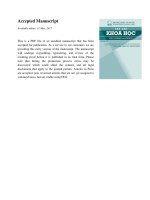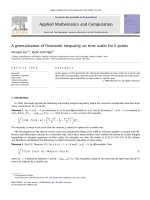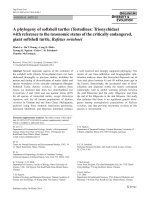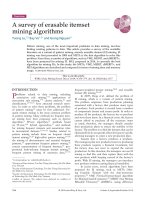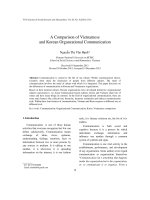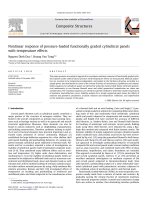DSpace at VNU: A study of the energy enhancement of electron in radio frequency (RE) linear accelerator of iris loaded waveguards
Bạn đang xem bản rút gọn của tài liệu. Xem và tải ngay bản đầy đủ của tài liệu tại đây (206.8 KB, 6 trang )
Technical Note
H.-B. Nguyen, H.-L. Trinh, V.-T. Chau and V.-T. Nguyen
Kerntechnik downloaded from www.hanser-elibrary.com by Purdue University Library TSS on February 1, 2016
For personal use only.
A study of the energy enhancement of electron
in radio frequency (RF) linear accelerator
of iris loaded waveguards
In this paper, the Hamiltonian theory of particle motion has
been applied for developing the motion equations of electrons
in linear accelerator of Iris-loaded waveguides. Using J. C. Slater
asumption for determining electric field in Oz direction, the energy increase of electron in the guide wave pipe following the linacs resonance cavity with circulated electromagnetic distribution and repeat-cycle of given number of resonance cavities has
been developed. The energy gain of electron following the electron way in Oz axle direction of the accelerator with the different injection phase and phase shift of RF has been obtained.
The results indicate that the energy increase of electron depends
on the injection phase of RF and cell-to-cell phase shift.
1 Introduction
In theoretical scenario, to understand how charged particle is
gained energy by RF waves in Linac and how phase of RF
and geometrical structure of accelerator affect to accelerated
particle energy, orbit dynamics and particle energy in an RF
linear accelerator have been described using Hamiltonian
theory [1]. The Bessel functions in the vector potential may
be expanded, yielding linearized equations and the electric
field can be estimated by J. C. Slater [2] asumption of asymptotic electric field in Iris-loaded waveguide. In this paper, the
Hamiltonian theory using the full Bessel functions, i. e. without linearization is used to calculate the equations of motion
and gain energy of particle travelling in this waveguide in the
term of z component electric field and its Fourier expansion
coefficients. It showed that this energy depends on the injection phase of RF and cell-to-cell phase shift of periodic accelerator structure. The energy oscillation of accelerated electron strongly depends on RF phase shift from cell to cell. For
certain accelerator structure there is only one phase shift of
RF which makes the smallest oscillation of particle energy
gain from cell to cell. This phase shift is corresponding to
one which gives the best quality of particle energy gain.
2 Hamilton equation of charged particle in electromagnetic
When an electric charge q moves relatively in the variable
electromagnetic, the Hamilton equation describes its motion
is as below [1, 3]:
rffiffiffiffiffiffiffiffiffiffiffiffiffiffiffiffiffiffiffiffiffiffiffiffiffiffiffiffiffiffiffiffiffiffiffiffiffiffiffiffiffiffiffi
2
~ c2 þ qV:
H ¼ m2 c4 þ ~
p qA
0
258
ð1Þ
~ ¼ ðAr ; Ah ; Az Þ are [4]:
where the components of vector A
8
1 k a E ðzÞ
P
>
n n z
>
J1 ðan rÞ cosðkn z xtÞ
>
Ar ¼
>
>
an
x
n¼
1
>
>
<
n
P0
Ah;j
Ah ¼
>
j¼1
>
>
>
1 a E ðzÞ
>
P
n z
>
>
J0 ðan rÞ sinðkn z xtÞ
: Az ¼
x
n¼ 1
ð2Þ
with an is the coefficient of development of Fourier series; Ah,j
is the vector of statics magnetic; Ez(z) is the function of variable z ordination describing the electromagnetic towards Oz
axial; J0(anr) and J1(anr) are Bessel equation; an2 = k2 – kn2
with k is the total wave number; k = x/c, c is the light speed
in vacuum; x is the angle frequency of RF wave; kn is the
wave number in Oz axial, kn = kf + 2pn/d with kf is the phase
change following the length of resonance cavity; kf = U0/
d = xs/d = x/vg (vg is the velocity of RF in the wave pipe),
U0 = x.s is the phase change of RF when passes to each resonance cavity or cell-to-cell phase shift; s is the time for RF
pass over one cavity in wave pipe; and d is the length of cavity
in wave pipe of the accelerator.
Basing on some definitions as above, the relative motion of
a charged particle e might be expressed by the Hamilton
equation as
H¼
E20 þ ðpr
eAr Þ2 c2 þ
ph
r
eAh
2
c2 þ ðpz
eAz Þ2 c2
1=2
ð3Þ
where e is the element electric charge, E0 = m0c2 is the rest
energy of particle; and pr, ph and pz are the momentum components of particle in cylindrical coordinates.
In order to study the change of energy of charged particles
following the Oz axial, the physics variables which depend
on time could be transferred to depend on the independent
variable z. Therefore, the energy of particle and phase can
be presented as the function of z.
Using some variable change and Hamilton function change
methods [4 – 7], the Eq. (3) which expresses the energy vary to
the phase and particle trajectory in Oz direction might be
shown as:
dh
¼
dz
qKf pr;kin
¼
q& 00
pz;kin
1
X
n¼ 1
1
X
en
2pn
kn kJ1 ðan rÞsin
z þ k& 00
a
d
n¼ 1 n
en kJ0 ðan rÞcos
2pn
z þ k& 00
d
!
ð4Þ
where h = H/Hi, H is the energy of particle, Hi is the initial
ean Ez ðzÞ
; Ar* = cAr/Hi,
Hi k
energy of particle; e0 = E0/Hi; en ¼
Carl Hanser Verlag, München
79 (2014) 3
Technical Note
Ah* = cAh/Hi, Az* = cAz/Hi; pr,kin = pr – eAr*, ph,kin = ph – erAh*,
pz,kin = pz – eAz*; pr = cpr/Hi, ph = cph/Hi, pz = cpz/Hi are the extending momentum component of the particle in cylindrical
coordinates, respectively; B = –ct + kfz/k and Kf is the Hamilton function after variable change
Kf ¼
kf
h
k
h2
e20
eAr
pr
2
ph
r
eAh
2
1=2
eAz
ð5Þ
Kerntechnik downloaded from www.hanser-elibrary.com by Purdue University Library TSS on February 1, 2016
For personal use only.
Therefore, the change of energy of particle moving on electromagnetic towards the Oz direction can be calculated by
integrating Eq. (4) to find h(z). This means that if the initial
energy of particle Hi is known, the energy of particle in any
z position could be counted via h(z).
qKf
¼
q& 00
n¼ 1
en J0 ðan rÞk cos
2pn
z þ k& 00
d
2
d
an ¼
d&
¼
dz
ð6Þ
ð7Þ
where v is the speed of electron along the axial of wave pipe;
vg is the speed of RF wave in wave pipe.
In case of the electrons have speed which are approxid& 00
¼ 0 ) & 00 ¼ &0 ¼
mately with RF waves (v & vg), we have
dz
const. This lets to kB@ : kB0 in Eq. (6) also is constant for
the electron traveling beside the Oz direction.
In Eq. (6) at certain position r, due to h is the function of z
and when the particle starts to increase speed we have
h(z = 0) = –1, we might find out h by integrating Eq. (6) with
h is from (–1) to (h) and z is from (0) to (z):
h ¼ hðzÞ ¼
e0 kzJ0 ða0 rÞcosðk& 00 Þ
1
X
n¼ 1;n6¼0
en J0 ðan rÞ
kd
2pn
sin
2pn
dz þ k& 00
Zd
ð8Þ
n¼ 1;n6¼0
en J0 ðan rÞ
kd
2pn
sin
z þ k&0
2pn
d
1
ð10Þ
ð11Þ
an E0z ejðxt
kn zÞ
ð12Þ
n¼ 1
1
X
Ez ðzÞ ¼
an E0z cos
n¼ 1
2pn
z
d
ð13Þ
Applying to the delivery of electromagnetic in the wave pipe
with cell-to-cell phase shift U0, the coefficient an might be
counted as
an ¼
Zd
0
cosðkn zÞ
pffiffiffiffiffiffiffiffiffiffiffiffiffiffiffiffiffi dz
zðd zÞ
J0 ðan ra Þ
2
U0
U0
pJ0
þ np cos
þ np
d
2
2
¼
J0 ðan ra Þ
ð14Þ
From Eq. (14), it shows that the coeffients an depend on the
phase shift U0, cell length d and aperture radius ra. Using
Eq. (14) with the parameters of linear accelerator RF as given
in Table 2, the value of an in the linear accelerator works on
the different phas shifts of U0 = 2p/3, p/3, p/2, and p have been
calculated and shown in Table 1. It is to noted that due to the
value of an decreases when subscript n increases, some value
of an are tiny with n = £ 3 and n ‡ 4.
Substituting coefficient an into Eq. (9) with n runs from –3
to 4, the equation of electron accelerating energy in electromagnetic in the wave pipe with repeat after three speed enhance cavities can be presented as:
hðzÞ ¼
e
Hi
4
X
a0 z cosðk&0 Þ þ
an E0z cos
2pn
z
d
4
X
n¼
d
2pn
an
sin
z þ k&0
2pn
d
3;n6¼0
1
!
ð15Þ
Eq. (15) can be used to count H energy of electron at any z
ordinates.
ð9Þ
Eq. (9) shows the relationship between electron energy and
its position towards the moving direction at the certain constant position r. In this case, the electrons move beside the
Oz axial and their speed are approximate with the velocity
of wave group. Furthermore, en in Eq. (9) depends on the
delivery of electromagnetic at the z direction. Therefore, it is
necessary to measure this parameter to find out the energy
of particle varies to the moving direction as Oz direction. In
79 (2014) 3
1
X
n¼ 3
e0 kzJ0 ða0 rÞ cosðk&0 Þ
1
X
kn zÞ
e jkn z
pffiffiffiffiffiffiffiffiffiffiffiffiffiffiffiffiffi dz
zðd zÞ
0
Substituting B@ = B0 into Eq. (8), we have:
hðzÞ ¼
an E0z J0 ðan rÞejðxt
J0 ðan ra Þ
2
d
c c
þ
v vg
n¼ 1
Due to the delivery of electromagnetic is symmetry, E(z,t) is
the even function and substitute xt –knz = xz/vg – knz = (kf –
kn)z = –2pnz/d, the Eq. (12) can be rewritten as
The new variable B@ is
00
1
X
Using J. C. Slater asumption [7] for asymtoptic of Ez(r,z)
when r is equal to aperture radius, and z is equal to zero and
d, an will be determined as.
Ez ðz; tÞ ¼
Considering the electrons move along z direction of the wave
pipe which have trajectory the same with Oz axial. It is assumed that there is no motion of electron in r and h directions. It means that the momentum components of the particle in these direction are equal to zero pr = pr = ph = ph = 0
and Ar* = Ar = Ah* = Ah = 0. This could let to pr,kin = pr –
eAr* = 0 = ph,kin = ph – erAh*. Substituting these variables into
Eq. (4), the Hamilton can be expressed as
dh
¼
dz
Ez ðr; z; tÞ ¼
where ra is aperture radius.
The electromagnetic at Oz axial of wave pipe (or r = 0)
could be as
3 Energy gain of electron which have same trajectory
with Oz axial
1
X
general case, the strength of electromagnetic in the wave pipe
can be determined as [8]:
HðzÞ ¼
Hi hðzÞ
ð16Þ
4 Results and discussion
In the study, the energy gain and oscillation of electron when
it moves on axial of wave pipe is considered. Assumption that
a linear accelerator RF is designed by the parameters [4] presented in Table 2.
259
Kerntechnik downloaded from www.hanser-elibrary.com by Purdue University Library TSS on February 1, 2016
For personal use only.
Technical Note
The parameters in Table 2 are set up for a linear accelerator
RF which is used to study the increase and decrease of the
electron energy at phase shift of 2p/3, p/3, p/2 and p.
When the linear accelerator works at regime of U0 = 2p/3,
the delivery of electromagnetic in the wave pipe would be in
circulation and repeat after three speed enhance resonance
cavities. Especially, if wave phase of RF is p/6, the delivery
of electromagnetic might be not in symmetry.
The variation of electron energy has been investigated and
the results indicate that the electron energy might increase
up to 20 times when it moves in the wave pipe length of one
meter. The average of energy enhance depends on the parameters of linear accelerator RF such as the maximum electric
field of RF wave, the initial energy of electron, the form and
size of speed enhance resonance cavity, injection phase and
phase shift of RF. The initial energy of electron is higher, the
electric field of RF wave needs to be more strong in order to
the speed enhance is more effectiveness.
Figure 1 shows the gradually enhancement of particle energy gain following z position when the electron moves. This
indicates that electron energy increases gradually. However,
the enhancement of electron energy has not been continuously, it has decrease energy stage between the increase energy stages.
It points out that the increase of speed of electron is not linearly. It enhances with the combine of linear and sin function.
The reason is the increase of speed of electron in wave pipe is
not continuously as mentioned above. This agrees with the
real case due to there is a haft time for increase speed of electron and other haft time for reducing speed in a cycle of RF
wave with a position. This effect make the accelerated electron energy oscillate from cell to cell. When the electron
moves to the RF wave area with suitable phase, the time for
increase its speed would be higher than one for decrease
speed. Therefore, finally the electron energy would enhance
gradually.
The effectively of speed enhancement depends on kB0 injection phase of RF wave as shown in Fig. 2. As mentioned on
section II, kB0 phase of RF wave has not changed when the
electron moves towards the Oz axial. The motion of electron
in wave pipe with different phase of RF wave as p/6, p/3, and
p/2 has been investigated. The electron energy increases
quickly when phase of RF wave is p/6 and the effectively of
speed enhancement reduces rapidly for phase of RF wave is
p/3. Furthermore, the increase of electron speed does not occur with phase of RF wave is p/2 and the electron energy varies a little comparing to the initial value. In opposite, the electron energy reduces gradually with phase of RF wave is 2p/3.
In this case, RF wave plays as a barrier to the motion of electron. In order to study the other effects on the speed enhancement of electron with different phase of RF wave, the change
of electron energy when it moves passing the first three speed
Table 1. The value of an
U0
2p/3
a–3
–8.8 ·
a–2
10–3
–4.0 ·
10–2
a–1
–1.9 ·
10–1
a0
1.0
a1
2.3 ·
10–1
a2
5.1 ·
a3
1.1 ·
10–2
10–2
a4
2.5 · 10–3
U0
a–3
a–2
a–1
a0
a1
a2
a3
a4
p/3
4.5 · 10–3
2.0 · 10–2
7.8 · 10–2
1.0
2.2 · 10–1
5.0 · 10–2
1.0 · 10–2
2.4 · 10–3
U0
a–3
a–2
a–1
a0
a1
a2
a3
a4
p/2
–4.5 · 10–4
–2.7 · 10–3
–2.3 · 10–2
1.0
2.3 · 10–1
5.1 · 10–2
1.1 · 10–2
2.5 · 10–3
U0
a–3
a–2
a–1
a0
a1
a2
a3
a4
p
2.5 · 10–1
6.8 · 10–1
1.0
1.0
6.8 · 10–1
2.5 · 10–1
7.8 · 10–2
2.2 · 10–2
Table 2. Parameters of linear accelerator RF
260
Parameters
Symbol
Value
Unit
length of wave pipe
L
1.0
M
length of speed enhance cavity
d
0.033
M
aperture radius
ra
0.008
M
maximun strength of electromagnetic on Oz direction
E0z
3.0 · 107
V/m
frequency of RF wave
f
2.998 · 109
Hz
angle frequency of RF wave
x
1.884 ·
1010
rad/s
velocity group of RF wave
vg
2.968 · 108
m/s
phase change of RF wave per length
kf
63.467
rad/m
electron energy when it starts increase speed
Hi
1.5
MeV
injection phase of RF wave in wave pipe
k&0
p/6
rad
79 (2014) 3
Technical Note
Kerntechnik downloaded from www.hanser-elibrary.com by Purdue University Library TSS on February 1, 2016
For personal use only.
enhancement cavities has also been investigated and shown in
Fig. 3. The results are well agreement to the independent
study which were presented by the Eindhoven Technology
University, Netherland on 1996 [5].
The oscillation of accelerated electron energy which affects
to quality of accelerated beam at output of wave guide is investigated at the different phase shifts U0 = 2p/3, p/3, p/2,
and p with the injection phase kB0 = p/6 as shown in the
Fig. 1. The enhancement of energy of electron
during it moves in wave pipe (initial energy of
electron is 1,5 MeV, accelerator works at U0 =
2p/3, injection phase of RF wave is kB0 = p/6)
Fig. 2. The effect of kB0 phase of RF wave on
the speed enhancement of electron
Fig. 3. The effects of phase of RF wave on the
speed enhancement of electron when it moves
passing the first three speed enhancement cavities
79 (2014) 3
261
Kerntechnik downloaded from www.hanser-elibrary.com by Purdue University Library TSS on February 1, 2016
For personal use only.
Technical Note
Fig. 4. The greatest oscillation of energy gain occurs at the
phase shift U0 = p. When the electron passes from cell to cell,
the electron energy rapidly increases at the end of cell and
gets maximal value at position z = nd (n is n-th cavity) and
then this energy rapidly decreases to nearly the initial energy.
As shown in the Fig. 4, the more cell electron passes, the
greater peak of electron energy is. In this phase shift, the obtained energy of electron therefore is very not stable. It cannot be used to accelerate electron.
The oscillation of electron energy is smaller in the other
phase shifts as shown in the Fig. 5 for electron passing the first
three cells. The electron energies in these phase shift are steadily increased when the electron passes from cell to cell. The
smallest energy oscillation occurs at the phase shift U0 = 2p/
3. In this phase shift the increment energy of electron is almost linear in z. This is the best phase shift for accelerating
electron in linac structure with parameters given in Table 2
and this phase shift is also operating phase shift of this accelerator structure given in reference [4]. This result pointed
out that this simple method can be used to find the suitable
phase shift and injection phase of RF for some given structure
of linear accelerator RF.
5 Conclusions
By using theoretical analysis, the accelerated particle energy
which is altered by the effects of phase shift and injection
phase of RF depending on geometrical accelerator structure
and RF frequency are studied. The quality of linear accelerator can be determined by the enhancement and oscillation of
the accelerated particle energy. This study showed that for
given accelerator structure there is only the best couple of
phase shift and injection phase of RF which makes the accelerated particle energy steadily increase. The other phases will
make less energy enhancement or more energy oscillation.
This can be confirmed by applying this theory to the accelerator with parameters given in Table 2 [4]. The results indicate
that the best phase shift and injection phase are U0 = 2p/3
and kB0 = p/6 respectively. These phases are consistent with
its operating phases given by reference [4]. To confirm this legitimate approach, however, the further calculations in the
other linear accelerator structures have to be carried out in
our next work.
Fig. 4. The effects of phase shift of RF wave on
the oscillation of energy gain of electron
Fig. 5. The effects of phase shift of RF wave on
the energy gain of electron when it moves passing the first three speed enhancement cavities
262
79 (2014) 3
Technical Note
Acknowledgements
The authors appreciate the support received from the National Key Laboratory of Digital Control and System Engineering (DCSELAB), Vietnam National University Hochiminh City, Vietnam, under contract No. 01TK/2012/HÐ/
KHCN-DCSELAB.
(Received on 17 November 2012)
Kerntechnik downloaded from www.hanser-elibrary.com by Purdue University Library TSS on February 1, 2016
For personal use only.
References
1 Reiser, M.: Theory and Design of Charged Particle Beams. Wiley –
VCH
2 Slater, J. C.: Electromagnetic Waves In Iris-Loaded Waveguides.
Technical report No. 48 (1947) MIT
3 Rosenzweig, J. B.: Fundamentals of Beam Physics. Oxford 2002
4 de Leeuw, R. W.: The accelerator injection chain of the electron storage ring. EUTERPE, Eindhoven University of Technology, Netherlands, 1996
5 Hammen, A. F. J.; Corstens, J. M.; Botman, J. I. M.; Hagedoorn, H.L.;
Theuws, W. H. C.: Hamiltonian calculation on particle Motion in Linear electron accelerators. Proc. of the fifth European Particle Accelerator Conference, Barcelona (1996) pp. 716 – 718
6 Corstens, J. M.; Hammen, A. F. J.; Botman, J. I. M.: Particle Dynamics
In Low-Energy Travelling – Waves Linacs. Proceedings of the
1999 Particle Accelerator Conference, New York (1999) pp. 866 –
868, DOI:10.1109/PAC.1999.792964
7 Terrall, J. R.; Slater, J. C.: Particle dynamics in the linear accelerator.
Massachusetts Institute of Technology, USA, 1951
8 Pruiksma, J. P.; de Leeuw, R. W.; Botman, J. I. M.; Hagedoorn, H. L.;
Tijhuis, A. G.: Electromagnetic Fields In Periodic Linear TravellingWave Structures. Proc. XVIII International Linear Accelerator Conference (1996) pp. 89 – 91
The authors of this contribution
Huy-Bich Nguyen, Ph. D.
Faculty of Engineering and Technology
Nong Lam University
Linh Trung Ward, Thu Duc District, Hochiminh City
Vietnam
E-mail: or
and
National Key Laboratory of Digital Control
and System Engineering (DCSELAB)
National University
268 Ly Thuong Kiet St., District 10, Hochiminh City
Vietnam
Hoa-Lang Trinh, MSc.
Faculty of Physics – Physical Engineering
Natural Science University
227 Nguyen Van Cu St., District 5, Hochiminh City
Vietnam
and
National Key Laboratory of Digital Control
and System Engineering (DCSELAB)
National University
268 Ly Thuong Kiet St., District 10, Hochiminh City
Vietnam
Van-Tao Chau, Assoc. Prof. Dr.
Faculty of Physics – Physical Engineering
Natural Science University
227 Nguyen Van Cu St., District 5, Hochiminh City
Vietnam
Van-Tuong Nguyen, MSc.
Faculty of Physics – Physical Engineering
Natural Science University
227 Nguyen Van Cu St., District 5, Hochiminh City
Vietnam
Bibliography
DOI 10.3139/124.110325
KERNTECHNIK
79 (2014) 3; page 258 – 263
ª Carl Hanser Verlag GmbH & Co. KG
ISSN 0932-3902
Books · Bücher
Near Surface Disposal Facilities for Radioactive Waste.
IAEA Safety Standards Series No. SSG-29, Published by the
International Atomic Energy Agency, 2014, ISBN 978-92-0114313-6, English, 103 pp., 36.00 EUR.
The objective of this Safety Guide is to provide guidance
and recommendations relating to the development, operation,
closure and regulatory control of facilities for the near surface
disposal of radioactive waste to meet the safety requirements
established in SSR-5. It is primarily intended for use by those
involved with policy development and with the regulatory
control and use of near surface disposal.
The term \near surface disposal" is used in this Safety
Guide to refer to a range of disposal methods, including the
emplacement of solid radioactive waste in earthen trenches,
above ground engineered structures, engineered structures
just below the ground surface and rock caverns, silos and tunnels excavated at depths of up to a few tens of metres underground. This Safety Guide provides general guidance for the
development, operation and closure of facilities of this a near
surface disposal facility is not provided in this Safety Guide.
IAEA safety standards for fuel cycle facilities and for the predisposal management of waste apply for this type of facility.
Nuclear security aspects of the disposal of radioactive waste
79 (2014) 3
in near surface facilities are outside the scope of this publication. However, this Safety Guide does identify where security
measures are relevant for safety purposes. Guidance on addressing nuclear security aspects can be found in the IAEA
Nuclear Security Series publications.
Section 2 provides an overview of near surface disposal
and its implementation, and the step by step approach to developing a near surface disposal facility. Section 3 provides
guidance on legal and organizational infrastructure. Section 4
discusses the safety approach and design principles, and Section 5 provides guidance for the preparation of the safety case
and safety assessment. Section 6 presents guidance for specific
steps in the development, operation and closure of a near surface disposal facility. Section 7 provides guidance on assurance for safety, and Section 8 deals with existing disposal facilities. Appendices I and II provide additional information
and guidance concerning the siting of near surface disposal facilities, specifically concerning data needs.
IAEA Safety Standards Series SSR-5 establishes 26 safety
requirements that are applicable to the near surface disposal
of radioactive waste. For convenience and traceability, the
text of each requirement in SSR-5 is reproduced in this Safety
Guide and is followed by the related recommendations.
263
